22 The Story of the Lady and the Unicorn
The Story of the Lady and the Unicorn: Selected Art Images and Related Texts
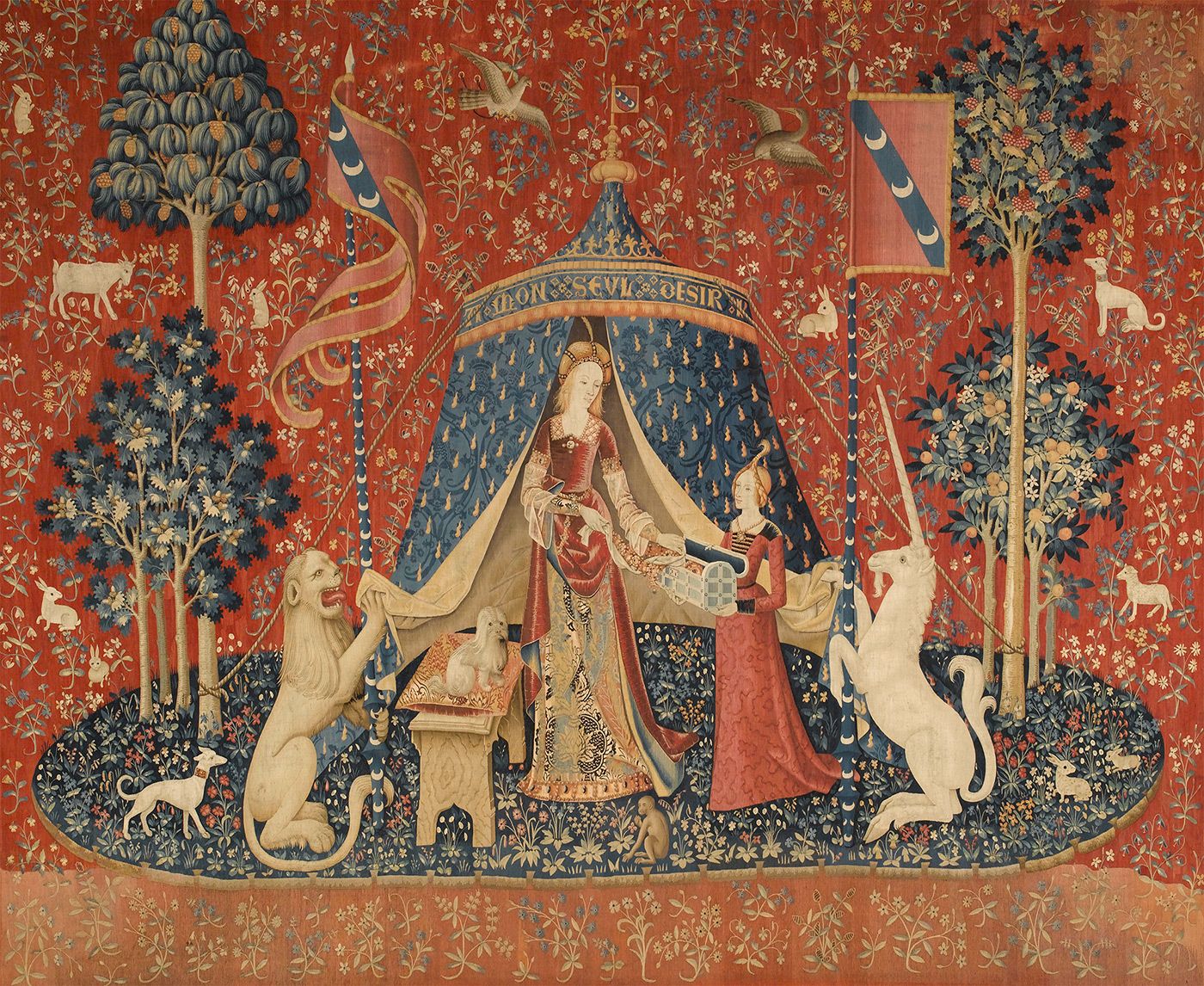
Elusive Beauty: The Unicorn Tapestries of the Musée de Cluny/Musée national du Moyen Âge, Paris.
The Lady and the Unicorn is the theme of a series of six famous 15th century silk and wool tapestries that are located at the Cluny Museum of Medieval Art (Musée Cluny) in Paris, France These tapestries have been the source of inspiration for artists, poets, novels, and playwrights. The lady may be based on Queen Mary Stuart, the younger surviving daughter of King Henry VII of England and Elizabeth of York, and the third wife of Louis XII of France, who was more than 30 years older than she was. The animals in the tapestries may represent the five senses: sight, touch, hearing, olfactory, and taste. There is an elusive and mysterious aura about these tapestries, very much like the mystery of the Mona Lisa located in the Louvre. The message “Mon seul désir” (To my only desire ) is a universal expression of love and duty. The exquisite details of the lady’s person and the intricate attention to the flowers, animals, and trees against a regal red background sustains the tapestries’ vibrancy throughout the generations. The lion and the unicorn appear to protect the lady. Archetypal human experiences and emotions are represented by the animal and floral detail. The lady’s personality , as well as the poetry of human experience, are alluded to with symbolic flowers, animals and trees against a rich red ground. The dynamic, intricate, and vibrant detail in the tapestries prevent one of the finest examples of art from the Middle Ages from being forgotten. The archetypal image, beauty of the flora and fauna, and sheer artistry continue to inspire the imagination. The symbolism and images are open to interpretation.
The Lady and the Unicorn (French: La Dame à la licorne) also called the Tapestry Cycle is the title of a series of six Flemish tapestries depicting the senses.
Source: The Unicorn Tapestries: Alexandra Kelly, 2022. Allegory of Christ or a Happy Husband? The Daily Art Magazine, 2022
https://www.dailyartmagazine.com/the-unicorn-tapestries-allegory-of-christ-or-a-happy-husband/
https://www.musee-moyenage.fr/en/collection/the-lady-and-the-unicorn.html
Hunt for the Unicorn (Folktale from Kendall, Norell, and Ellis, 2016)
“Once upon a time, a hunter in a forest saw a brilliant white unicorn in the distance, emerging from a river and gleaming like the moon. Enchanted by the sight, the hunter called together his friends and gave chase. But the unicorn knew that men could never catch him, so he playfully waited for the hunters to draw close before bounding out of view.
After a while, the unicorn came to a stop in front of a beautiful young woman sitting under a tree. She reached out, combed his curling mane, and rubbed his horn until he lay his head in her lap. But it was a trap!
Looking up at the maiden, the unicorn saw her brown eyes were filled with tears and realized her deceit too late—the dogs and men suddenly seized him and carried him away.
Afterward, the maiden remained in the woods, despondent. As she leaned down to wash away her tears in the stream, a movement in the distance caught her eye; she couldn’t be sure, but she thought it was the shining horn of a unicorn disappearing in into the night. (p. 73)”
Source: Mythic creatures and the impossibly real animals who inspired them. Laurel Kendall, Mark A. Norell, and Richard Ellis (2016), and the American Museum of Natural History Exhibition Department, New York City, NY (p. 73). Sterling Signature.
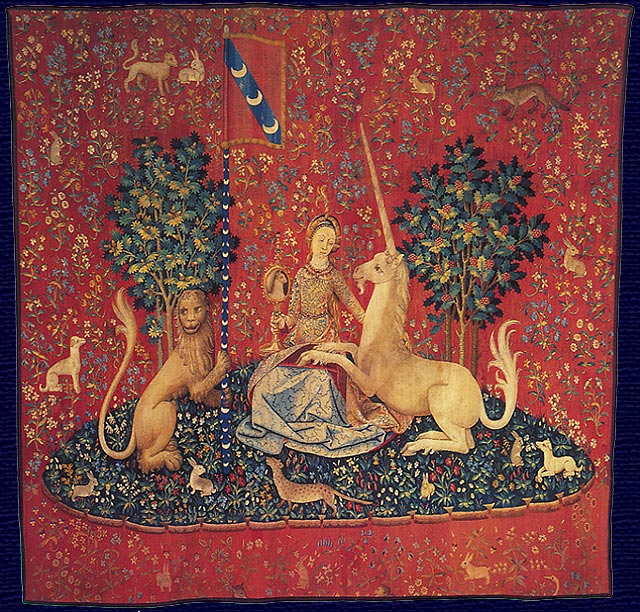
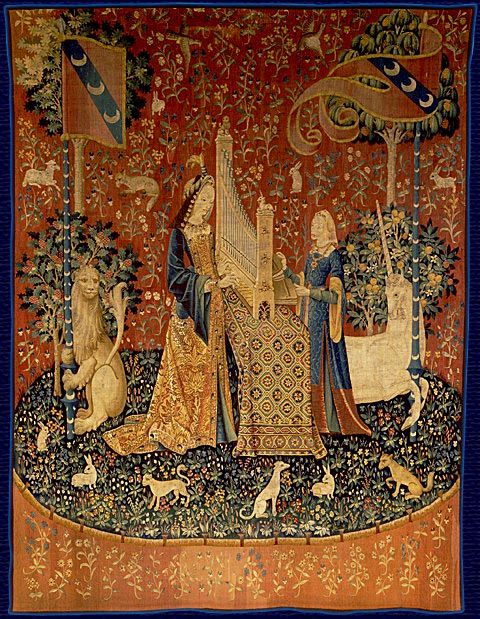
The Hunt of the Unicorn Tapestries at The Cloisters Art Museum, Metropolitan Museum of Art, New York.
The Unicorn Tapestries (12 feet high) featured at The Cloisters (The Met Cloisers) a division of the Metropolitan Museum of Art that specializes in European medieval art and architecture with a focus on Romanesque and Gothic periods. There is an extraordinary attention to details in nature (flowers, tiny animals) that give the tapestries vitality. Emotions are evoked and each person may find their own meaning in the particular scene. The unicorn tapestries feature a world of wonder and imagination where the mysterious bond between human, animals, and the larger universe prevail. Existential themes of goodness, evil, life, and death are present in the tapestries.
Metropolitan Museum Art Notes
“The seven individual hangings known as “The Unicorn Tapestries,” are among the most beautiful and complex works of art from the late Middle Ages that survive. Luxuriously woven in fine wool and silk with silver and gilded threads, the tapestries vividly depict scenes associated with a hunt for the elusive, magical unicorn. “The Unicorn Rests in a Garden” may have been created as a single image rather than part of a series. In this instance, the unicorn probably represents the beloved tamed. He is tethered to a tree and constrained by a fence, but the chain is not secure and the fence is low enough to leap over: The unicorn could escape if he wished. Clearly, however, his confinement is a happy one, to which the ripe, seed-laden pomegranates in the tree—a medieval symbol of fertility and marriage—testify. The red stains on his flank do not appear to be blood, as there are no visible wounds like those in the hunting series; rather, they represent juice dripping from bursting pomegranates above. Many of the other plants represented here, such as wild orchid, bistort, and thistle, echo this theme of marriage and procreation: they were acclaimed in the Middle Ages as fertility aids for both men and women. Even the little frog, nestled among the violets at the lower right, was cited by medieval writers for its noisy mating.” (Metropolitan Museum of Art Notes Retrieved March 26, 2023
https://www.metmuseum.org/art/collection/search/467642 ).
To listen and read the story of “The Hunt of the Unicorn” please access the Metropolitan Museum link below.
https://www.metmuseum.org/primer/met-cloisters/unicorn-tapestries-story
Art and Nature in the Middle Ages
In “Art and Nature in the Middle Ages” Elisabeth Taburet-Delahaye (2016) writes:
Nature’s place in medieval art and literature
The four elements (earth, air, fire, and water, the plant world, and the animal kingdom were present in art as they were in poetry. Painters and sculptors neve tired of them, and it is perfectively legitimate to read the history of medieval art as that of an increasing preoccupation with representing nature….Toward the end of the 12th or the beginning of he 13th century, artists’ careful observations of the plant world produced depictions of species so accurate that they are easily identifiable. Similar scrutiny of the rhythms of the days and the seasons led, from the end of the 14th century onward, to painting on night, dawn, and sunset, to the reveries of springtime, or the white mantle of winter snow. A broader vision of the surrounding world began to produce realistic landscapes and evocations of the cosmos that extended well beyond accepted conventions. (p. 12).
Art and Nature in the Middle Ages. Dallas Museum. 2016.
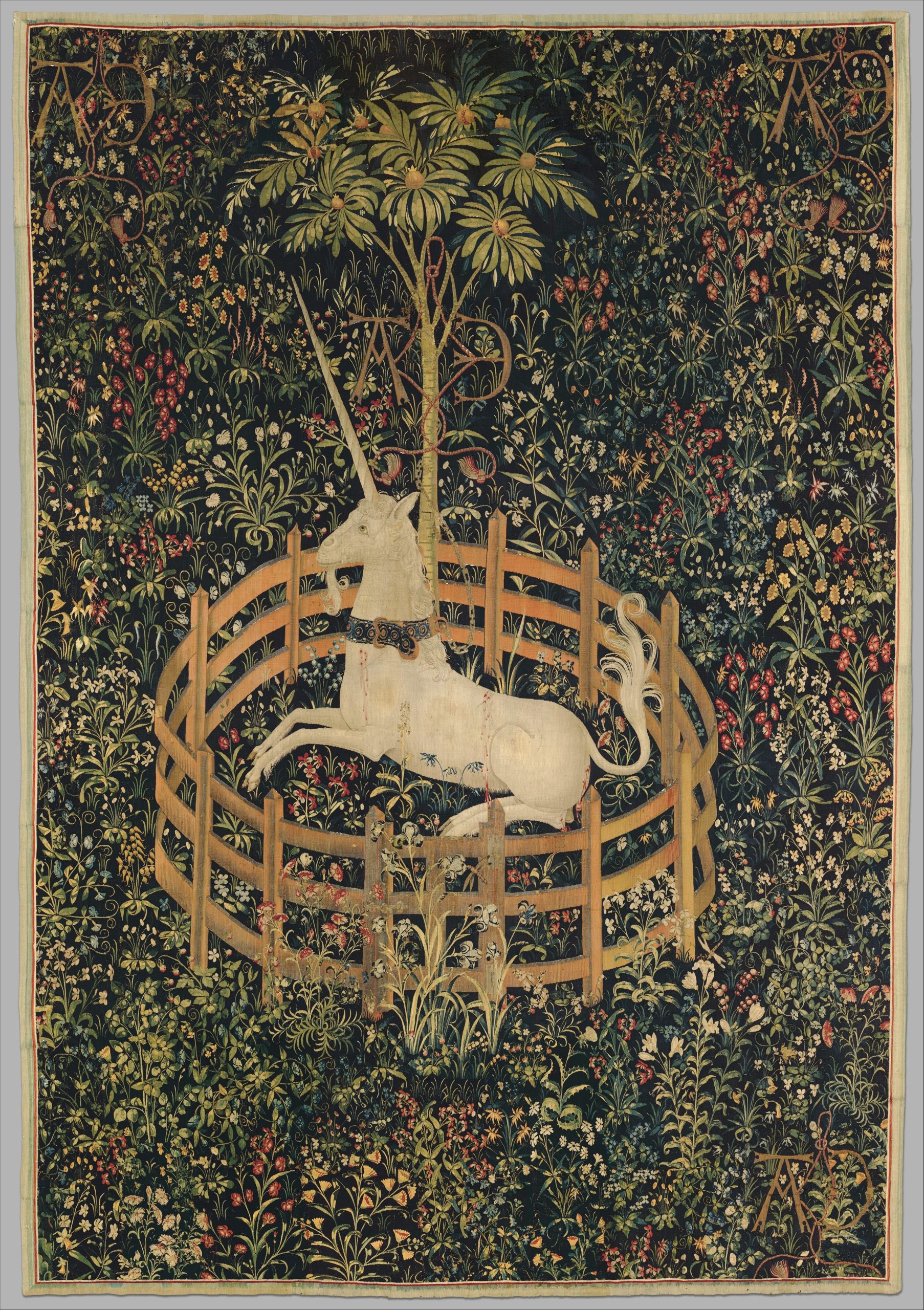
The Unicorn in Captivity may represent the theme of the “beloved tamed” as while the unicorn is constrained by a fence and tethered to a tree, he appears to be resting. The imagery and symbolism remain elusive and open to interpretation. https://images.metmuseum.org/CRDImages/cl/original/DP155501.jpg
https://www.metmuseum.org/art/collection/search/467642
Metropolitan Museum of Art, Gift of John D. Rockefeller Jr., 1937, New York City, NY.
Unicorn Resting in a Garden, Metropolitan Museum of Art, The Cloisters.
Excerpt about the history of the history by Michael Green (1983).
“Now of all the aspects of the Unicorn, what holds chief sway over the mind of Man is his Horn-spiraling, solitary, great, and powerful. Deservedly so, for that shaft is his talisman and his token also. In it is distilled all his strength, wisdom, and subtle understanding. The Horn is outward and visible, but is also the mystical and ungraspable form of this creature…In hue it is shining white, whiter than snow, smoother than ivory—yet vibrant with life, even more so than mortal flesh, and wedded to farthest-seeing senses. At once, it occupies both this and other realms, and is thus able to penetrate all substances. In times of danger or unwavering mental concentration, the Horn can display a certain glimmer or soft glow” -Michael Green, 1983, On the history and the truth of the unicorn, p.61.)
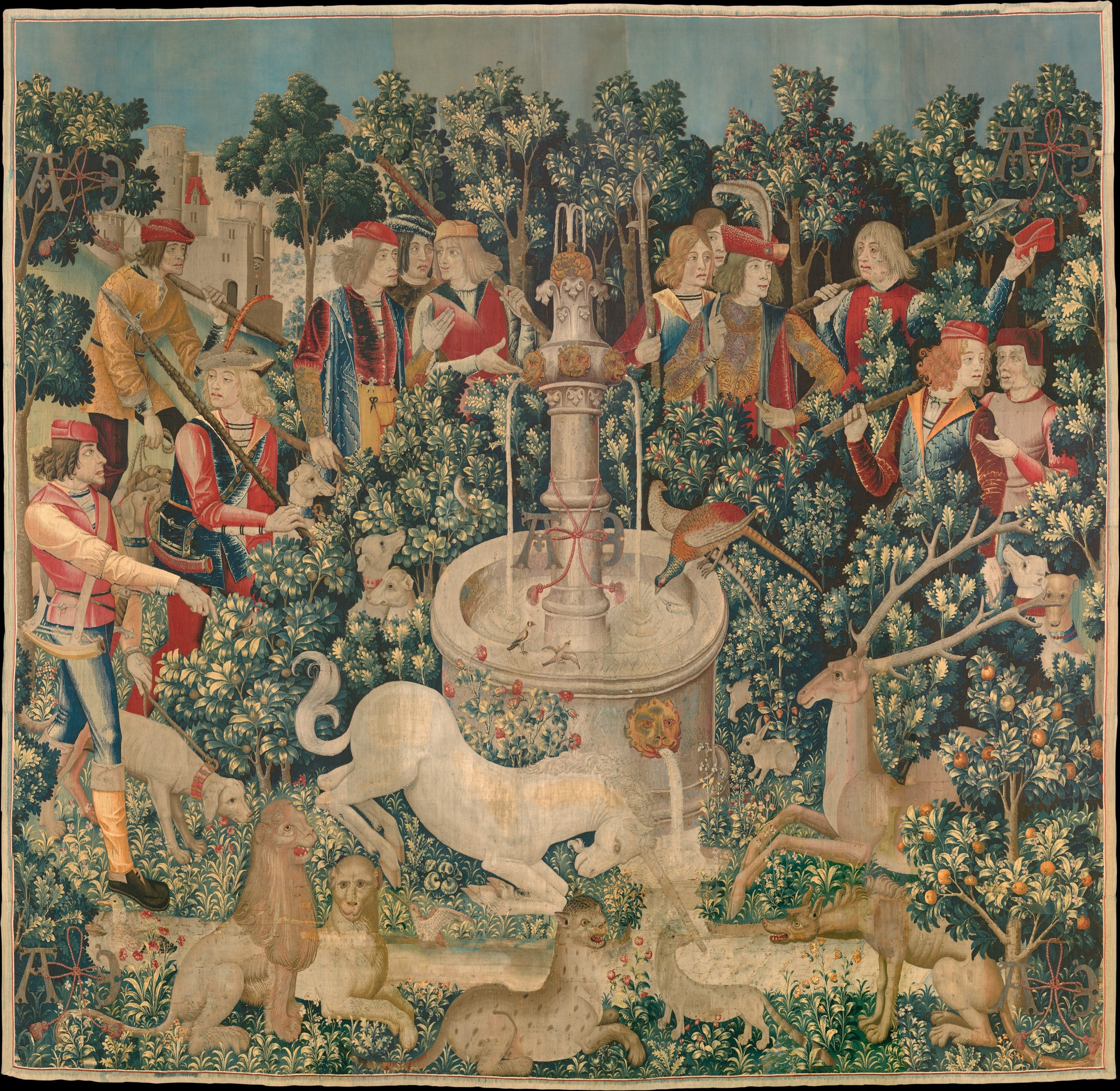
https://upload.wikimedia.org/wikipedia/commons/c/ca/The_Hunt_of_the_Unicorn_Tapestry_1.jpg
https://www.metmuseum.org/exhibitions/listings/2013/search-for-the-unicorn
For the Story of the Unicorn, please open the link for the Metropolitan Museum of Art (Cloisters Medieval Art Museum), New York.
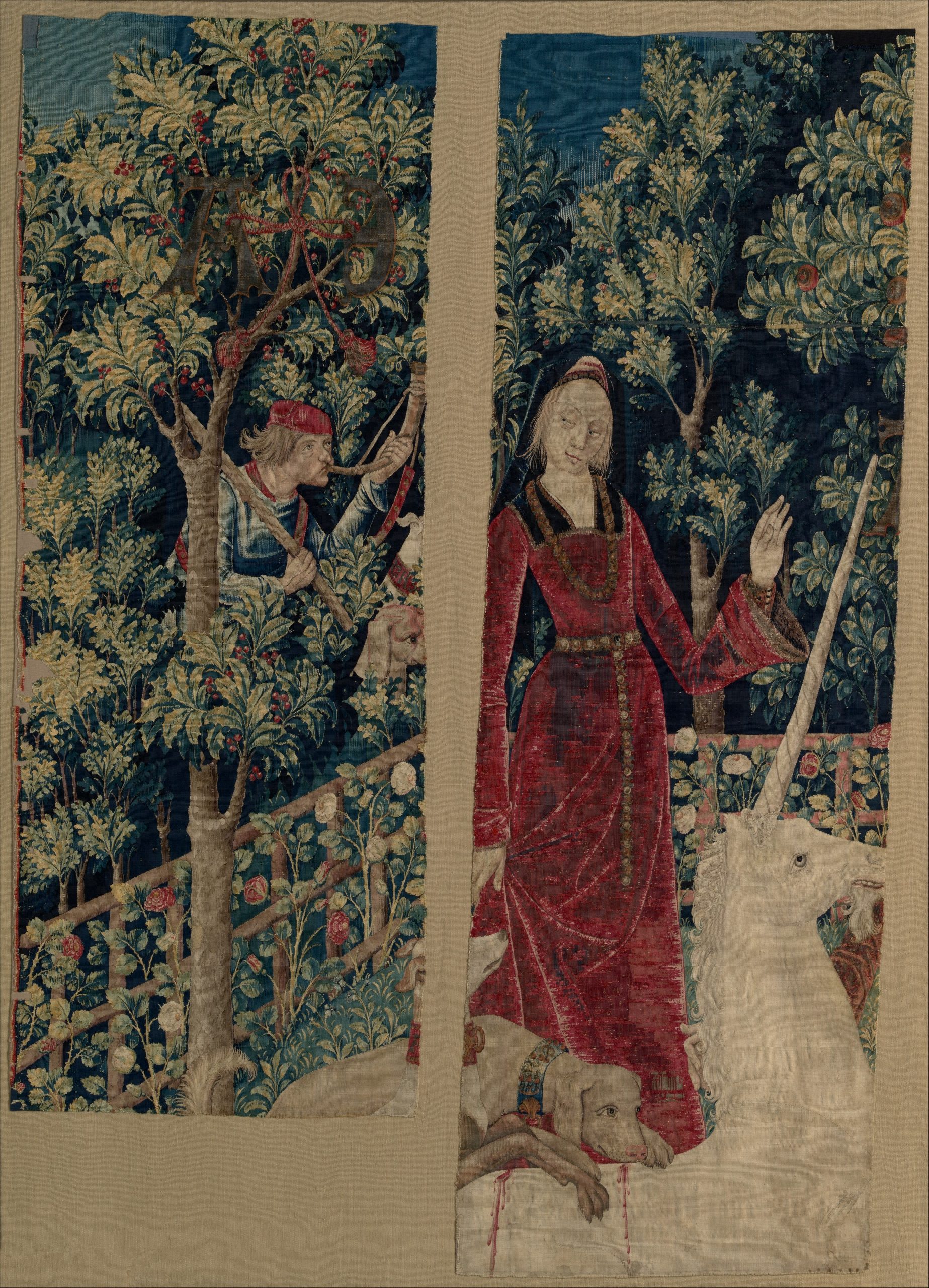
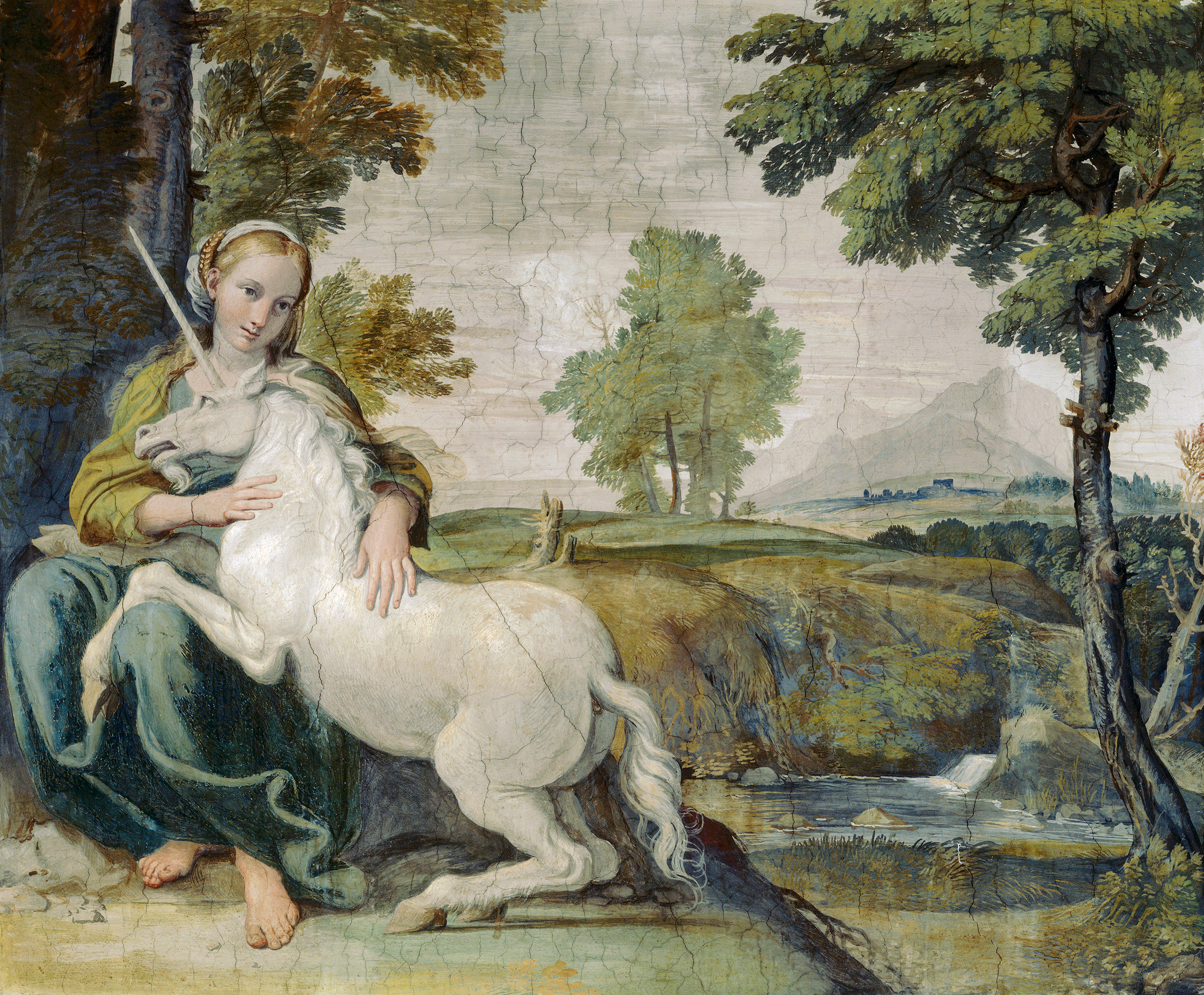
Teaching and Learning Resources Related to The Unicorn in Art/Tapestries.
The Folktale of the Unicorn
The Metropolitan Museum of Art
https://www.metmuseum.org/primer/met-cloisters/unicorn-tapestries-story
For teaching resources please open the Metropolitan Museum of Art link below.
https://www.metmuseum.org/learn/educators/lesson-plans/medieval-beasts-and-bestiaries
Animals in Medieval Art-Metropolitan Museum of Art.
https://www.metmuseum.org/toah/hd/best/hd_best.htm
The Hunt of the Unicorn by Robert Richman.
https://www.jstor.org/stable/20591204
https://www.poetryfoundation.org/poetrymagazine/browse?contentId=25447
Shel Silverstein-The Unicorn Poem.
https://allpoetry.com/poem/8538803-The-Unicorn-by-Shel-Silverstein
Additional Texts The unicorn from the start and other plays by W.B. Yeats and Lady Gregory. The MacMillan Company. 1908.
https://www.gutenberg.org/files/26144/26144-h/26144-h.htm
https://www.gutenberg.org/files/48351/48351-h/48351-h.htm
Ancient Origins: For more information about mythological animal hybrid creations, please open the link below.
https://www.ancient-origins.net/myths-legends/ten-mythological-creatures-ancient-folklore-001805
Physiologus:
https://en.wikipedia.org/wiki/Physiologus
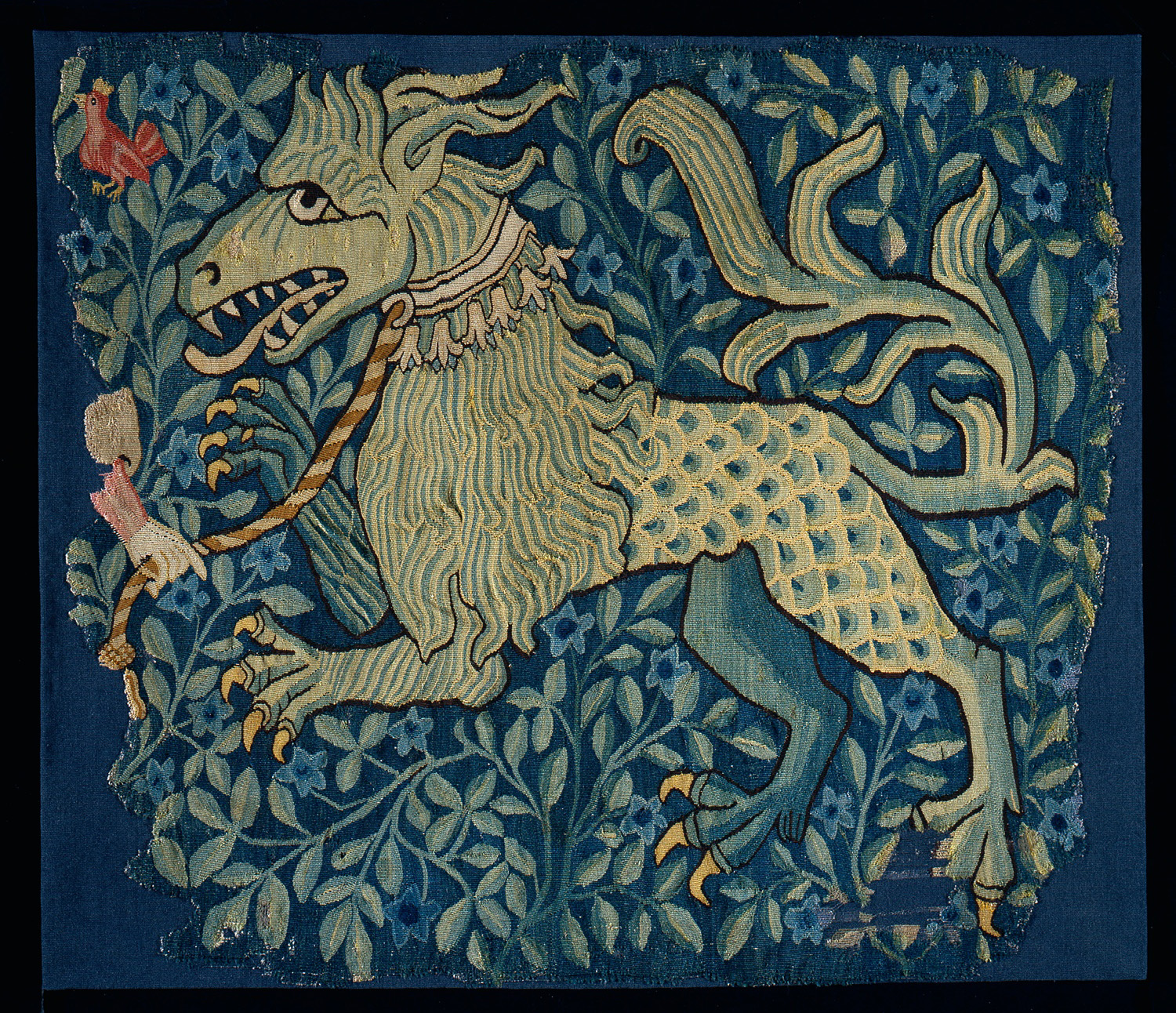
Also refer to:
The Cloisters Collection, 1990; OA/Public Domain. MET.
https://www.metmuseum.org/art/collection/search/466178
For more information about the Metropolitan Museum of Art Tapestries please open the link below.
https://www.metmuseum.org/toah/hd/taps/hd_taps.htm
Note about the Tapestry
This fantastical lion-like best with claws and a reptilian like back is a hybrid animal creation that had its roots in real life animals. Tapestries like this one not only had a decorative purpose; they also helped insulate the home from harsh weather. These animal-hybrids derived from Medieval Bestiaries and ancient texts like Physiologus where fantastical animals, birds, and hybrid creature amid rich landscapes were featured. Human vices, personality traits, and mora qualities were often ascribed to each animal.
Ancient Origins: For more information about mythological animal hybrid creations, please open the link below.
https://www.ancient-origins.net/myths-legends/ten-mythological-creatures-ancient-folklore-001805

